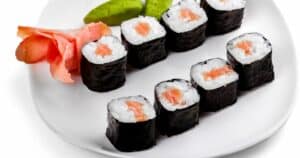Hey friends! If you’re anything like me, you love a good mango sticky rice dessert. The sweet sticky rice paired with the tropical mango is simply delicious. But you may be wondering – can you use sushi rice to make this tasty treat instead of traditional sticky rice?
I’m here to tell you that unfortunately, sushi rice won’t give you quite the same texture and flavor as sticky rice. While both are short-grain white rices, sticky rice gets its characteristic chewiness from higher starch content. Sushi rice is actually less sticky and has a more polished, firmer texture suited for rolled sushi.
However, if you’re really craving mango sticky rice and can’t find the specialty sticky rice, regular short-grain rice can work in a pinch! You’ll just want to make sure to soak it well and then steam it until nice and soft with coconut milk and sugar.
Curious to learn more about the secrets to perfectly sweet sticky rice? Keep reading for my pro tips and favorite recipe so you can make the best mango sticky rice at home! I’ll walk you through step-by-step so you can impress your friends with this irresistible tropical treat. Trust me, it’s easier than you think!
Sushi Rice vs. Sticky Rice
Though both are short-grain white rices, sushi rice and sticky rice are not the same.
Sticky rice, also called glutinous rice or sweet rice, has a higher starch content than other rice varieties. This makes it stickier and gives it a chewy texture when cooked.
Sushi rice is less starchy and actually contains a lower percentage of amylopectin, the sticky starch molecule. It has a more polished, firm grain compared to sticky rice.
This means sushi rice won’t give you the sweet, chewy texture you want in mango sticky rice. The rice will be too firm and not have the same mouthfeel.
Why Sticky Rice Is Better for Mango Sticky Rice
There are a few reasons why sticky rice is superior for making mango sticky rice:
- Texture – Sticky rice achieves the soft yet chewy consistency that perfectly complements the sweet mango. Sushi rice remains too firm.
- Flavor – Sticky rice has a sweetness that balances the tropical mango. Sushi rice tends to be plain.
- Appearance – When cooked, sticky rice is translucent and glossy. This looks more appetizing paired with the colorful mango.
- Stickiness – The high starch content of sticky rice allows it to clump together and stick to the juicy mango slices. Sushi rice separates more easily.
Can You Use Short-Grain Rice?
If you can’t find sticky rice, the next best substitute is regular short-grain white rice.
Though it won’t be quite as sticky as true glutinous rice, short-grain rice will work better than longer grain rices like jasmine or basmati.
Some tips when using short-grain rice:
- Soak the rice for 1-2 hours before cooking
- Add a bit more liquid than normal when cooking
- Stir in a little sweetener like sugar
- Cook it a bit longer until very soft
While it won’t be identical, with some adjustments you can still make tasty mango sticky rice with short-grain rice!
How to Make Perfect Mango Sticky Rice
To achieve the ideal texture and flavor, it’s important to use the right ingredients and techniques:
Ingredients
- Sticky rice – This provides the right chewy yet tender consistency. Soak for 1-2 hours before cooking.
- Coconut milk – Adds creamy richness and moisture to the rice. Light or full-fat work well.
- Sugar – A touch of sugar enhances the sweetness of the rice. White or brown sugar works.
- Mango – Look for ripe, sweet mangoes. Champagne, Ataulfo, and Kent varieties are great choices.
- Salt – A pinch of salt balances out the sweetness.
Directions
- Rinse sticky rice and soak for 1-2 hours. Drain well.
- Steam the rice for 15-20 minutes until soft and sticky.
- Stir in coconut milk, sugar, and a pinch of salt.
- Slice ripe mangoes.
- Serve rice warm or chilled, topped with mango slices.
Tips for Perfectly Sweet Rice
Here are some extra tips for nailing the ideal sticky rice texture:
- Use a rice cooker if possible for easy, foolproof rice.
- Let the rice rest for 5-10 minutes after cooking. This allows steam to distribute evenly.
- Gently fold the rice rather than stirring vigorously to keep grains intact.
- Add extra liquid like coconut milk if rice seems dry. More moisture = more sticky!
- Chill completed rice overnight to let flavors develop.
- Drizzle extra coconut milk on top when serving for added creaminess.
Get Creative with Toppings
While mango is the classic pairing for sticky rice, you can switch it up with other fun flavors:
- Fresh tropical fruit like pineapple, bananas, lychee, jackfruit
- Sweetened coconut flakes
- Chopped nuts like peanuts, cashews, or almonds
- Sweetened condensed milk
- Shredded coconut
- Pomegranate seeds
- Lime zest
So don’t be afraid to try combinations beyond the traditional mango with this versatile dessert!
Satisfy Your Mango Sticky Rice Craving
Mango sticky rice is one of my favorite treats, and I never want to miss out just because I don’t have the exact right rice on hand.
While sushi rice won’t provide the ideal texture, you can use short-grain rice in a pinch to make a tasty facsimile.
But for the real deal, get your hands on some sweet sticky rice and whip up a batch using the tips above. The soft, chewy rice pairs so perfectly with the tropical mango flavor.
Let me know if you have your own tricks for making mango sticky rice! I’m always looking to up my dessert game. Now get out there and enjoy this sweet Thai specialty. Your tastebuds will thank you.




